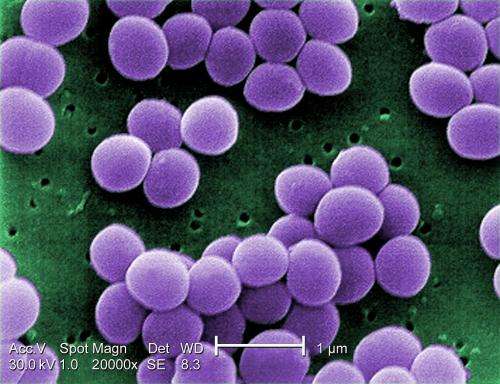March 16, 2015 report
Successful in vivo test of breakthrough Staphylococcus aureus vaccine

(Medical Xpress)—One of the largest problems in clinical medicine is the growing prevalence of multidrug-resistant, disease-causing strains of Staphylococcus aureus. Penicillin resistance is now extremely common across a spectrum of staph strains, and although a few new antibiotic approaches show promise, the general availability of these new drugs still lies years in the future.
S. aureus strains cause a wide range of serious and sometimes lethal illnesses, including osteomyelitis, endocarditis, pneumonia, meningitis and toxic shock syndrome. Methicillin-resistant S. aureus (MRSA) has taken a high toll in illness and death in hospital settings.
Recently, a collaborative of researchers from the Novartis Vaccines Research Center in Sienna, Italy and the University of Chicago have demonstrated a highly efficacious vaccine for epidemiologically relevant S. aureus strains that combines five conserved antigens known to play different roles in S. aureus pathogenesis. They have published the results of an in vivo study in the Proceedings of the National Academy of Sciences.
Antigen selection
Previous studies have demonstrated antigens with surface and secreted factors that are protective against S. aureus virulence. The researchers included two surface-exposed lipoprotein antigens; a lipoprotein involved in iron uptake and in early stages of invasive S. aureus infection; and three secreted virulence factors. These antigens were modified for exploitation as vaccine components, and the researchers named the combined vaccine 4C-Staph (short for four-component S. aureus vaccine).
S. aureus also produces many virulent factors which counteract most pathways of innate immunity in humans and animals, making it a troublesome pathogen to address clinically. One such factor is staphylococcal protein A (SpA), a known B-cell superantigen which, upon interaction with B cell receptors, induces clonal expansion and apoptosis, thereby dampening the body's immune response to staph infection.
To prevent SpA from destroying B-cells in lab mice, the researchers injected them with a nontoxigenic form of SpA (SpAKKAA) prior to administering 4-C Staph. "As expected," they write, "sera of mice immunized with SpAKKAA and then infected with S. aureus recognized all of the vaccine components."
Antigen teamwork
The four primary antigens the researchers selected were chosen based on their abilities to provide partial protection to infection by S. aureus. They hypothesized that the combination would work synergistically in vivo to provide broad protection against the pathogen. Mice were immunized with each antigen alone or with the combination of the four antigens formulated with aluminum hydroxide.
Following immunization, the mouse groups were challenged with sublethal doses of one of five strains of S. aureus; immunization with 4C-Staph resulted in a statistically significant reduction of bacterial load regardless of the challenge strain the researchers used compared with the control mice immunized with alum alone. The combined vaccine was also far more efficacious in protecting the mice compared to mice immunized with single antigen formulations.
Further improvements
A vaccine closer to ideal would induce both functional antibodies and T cell-mediated immunity. The researchers hypothesized that formulating 4-C Staph with an adjuvant stimulating such a response would enhance the protective properties of the vaccine. They added a molecule immune potentiator called SMIP.7-10, targeting Toll-like receptor 7, and tested it against peritonitis-causing staph.
Ten days after vaccination, the mice were challenged with a lethal dose of several S. aureus strains and showed 80 to 90 percent levels of protection, significantly higher than the previous formulation of antigens. Additionally, the researchers administered serum from vaccinated rabbits to unvaccinated mice, producing a similar protective effect that demonstrates that 4-C Staph provides antibody-mediated protection.
Results:
- The vaccine induces antibodies that target three secreted virulence factors
- It elicits antibodies that are opsonophagocytic and interfere with important biological functions
- It protected nearly 100 percent of mice from lethal doses of several different strains of S. aureus
The researchers also point out that two recent failed prophylactic vaccine trials administered formulations lacking adjuvants, indicating that a more vigorous stimulation of cell-mediated immunity, as with 4-C Staph, might be a key to efficacious vaccines.
More information: "Vaccine composition formulated with a novel TLR7-dependent adjuvant induces high and broad protection against Staphylococcus aureus." PNAS 2015 ; published ahead of print March 9, 2015, DOI: 10.1073/pnas.1424924112
Abstract
Both active and passive immunization strategies against Staphylococcus aureus have thus far failed to show efficacy in humans. With the attempt to develop an effective S. aureus vaccine, we selected five conserved antigens known to have different roles in S. aureus pathogenesis. They include the secreted factors α-hemolysin (Hla), ess extracellular A (EsxA), and ess extracellular B (EsxB) and the two surface proteins ferric hydroxamate uptake D2 and conserved staphylococcal antigen 1A. The combined vaccine antigens formulated with aluminum hydroxide induced antibodies with opsonophagocytic and functional activities and provided consistent protection in four mouse models when challenged with a panel of epidemiologically relevant S. aureus strains. The importance of antibodies in protection was demonstrated by passive transfer experiments. Furthermore, when formulated with a toll-like receptor 7-dependent (TLR7) agonist recently designed and developed in our laboratories (SMIP.7–10) adsorbed to alum, the five antigens provided close to 100% protection against four different staphylococcal strains. The new formulation induced not only high antibody titers but also a Th1 skewed immune response as judged by antibody isotype and cytokine profiles. In addition, low frequencies of IL-17–secreting T cells were also observed. Altogether, our data demonstrate that the rational selection of mixtures of conserved antigens combined with Th1/Th17 adjuvants can lead to promising vaccine formulations against S. aureus.
© 2015 Medical Xpress
















